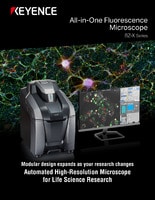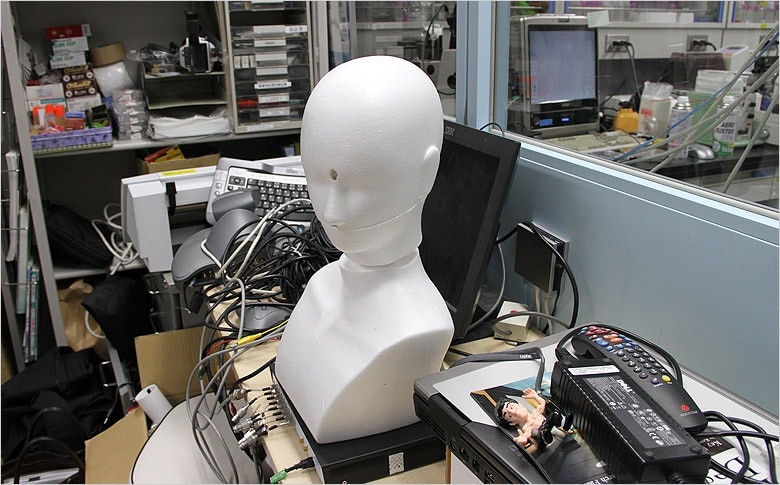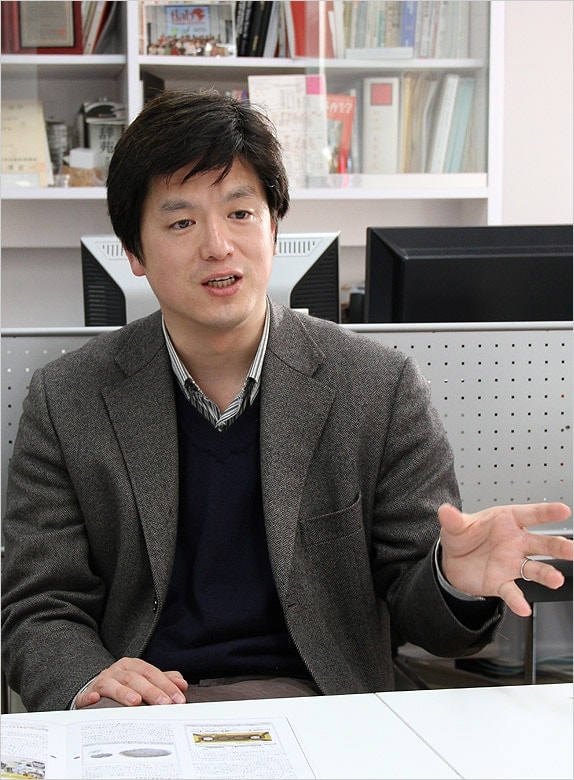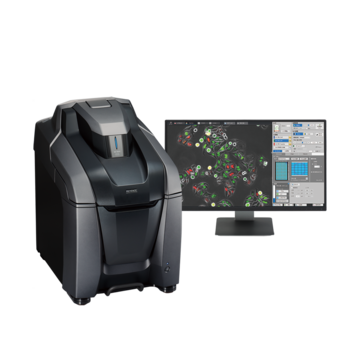Promoting Efficiency in Research With Compact, User-friendly Microscopes

Dr. Shoji Takeuchi
Professor, Biohybrid Systems Laboratory, University of Tokyo
Director, Collaborative Research Center for Bio/Nano Hybrid Process
He graduated from the Department of Mechano-Informatics, the University of Tokyo in 1995 and completed his PhD in the Department of Mechano-Informatics, Faculty of Engineering, the University of Tokyo in 2000. Later, he played several roles, including special researcher at the Japan Society for the Promotion of Science and assistant professor of the Biohybrid Systems Laboratory of the University of Tokyo. He then became an associate professor of this laboratory in 2007. In 2008, he was also assigned as the director of the Collaborative Research Center for Bio/Nano Hybrid Process at the laboratory. In 2014, he was promoted to become a professor of the laboratory. His research interests include nanobiotechnology, microfluidic device, MEMS, and bottom-up tissue engineering. He was awarded the Young Scientists’ Prize by the Minister of Education, Culture, Sports, Science and Technology in 2008 and the Japan Society for the Promotion of Science Prize in 2009.
Get detailed information on our products by downloading our catalog.
View Catalog

Production using cells as components.Aiming to create a new industry through industrial applications of biomaterials
Dr. Shoji Takeuchi at the Biohybrid Systems Laboratory of the University of Tokyo is engaged in research to transform difficult-to-handle biomaterials into easy-to-handle materials like industrial components.Under the theme of a hybrid of living organisms and mechanical engineering, he is trying to open up a new frontier in the field of production. In the field of nanobiotechnology, he has achieved several innovative research results, such as the formation of artificial lipid bilayer membranes. Recently, by proposing the microfabrication of hydrogel as a biocompatible material, he has explored new areas such as implanted devices and the 3D assembly of cells. This research will be used as the base for developing artificial cells. With this development, he hopes to contribute in the medical field and to create a new industry. To further this aim, he is actively engaged in applied research through business-academia collaboration, in addition to basic research.
We’re here to provide you with more details.
Reach out today!

01. Studied insect biomechanics during his undergraduate program

An image of the heart composed of artificial cells, drawn by a media artist in the laboratory. The members of the laboratory intend to gain a better understanding of their research in society through easy to understand publications of the contents of their research.
His laboratory is located in the Biohybrid Systems Laboratory of the University of Tokyo, with the motto “Think Hybrid” out front. This motto means to “create something new through the mixture of various research fields.” Exactly in line with this philosophy, the laboratory consists of a wide range of members, ranging from young researchers in fields such as robotics, electricity engineering, information systems, biology, chemistry, and materials to media artists, and every member of the laboratory is promoting advanced research and interacting with society.

A system in which living cells are used as sensors to detect the smell of a moth’s sex hormones. The robot is designed to shake its head according to the detected smell. The study results were published in the Proceedings of the National Academy of Sciences of the United States of America and were also introduced in the academic journal Cell.
Dr. Takeuchi’s search for a hybrid of living organisms and mechanical engineering started when he began to develop a robot to simulate movement of insects as a university student. At that time, he conducted experiments to make legs cut out of insects expand and contract by inserting electrodes into them to transmit electric signals. Later in his postgraduate days, he mounted devices on insect bodies to control their movement. Through these experiments, he hit on an idea to create a completely new device by applying the best functions of living organisms to machines. Then, he became interested in MEMS, a technology to produce micro machines.
His idea stood out in that he aimed to utilize MEMS outside the mechanical field and to produce machines at the level of cells or proteins by actively adopting biocompatible materials. His intention is to create a “machine that can interact with living bodies,” or a “machine that can work at the gene level.” With this aim, he is trying to make contributions in the medical field in 10 or 20 years. He also thinks that he has an important mission to influence the manufacturing industry through innovative technologies.
“Conventionally, machines are commonly made of silicon, metal, and plastic. Our laboratory, however, is studying how to use cells and proteins as mechanical materials. Our current challenge is to establish a design and processing methodology to achieve this,” said Dr. Takeuchi.
We’re here to provide you with more details.
Reach out today!

02. Succeeded in artificial cultivation of nerve cells and binding them with the brain

Implantation (transcription) of an artificial neural network made in a micro test tube onto a rat brain. The artificial network is bound to the brain to exchange signals.
(M. Kato-Negishi et al. Biomaterials, 2010)
Among various types of existing cells, Dr. Takeuchi has been working on nerve cells as his research focus since the beginning. He aims to cultivate nerve cells in high volume through an engineering approach so that they will be useful in spinal cord injury treatments and other recoveries of nerve functions.
“Conventional treatment to regenerate nerves injects neural stem cells into the body so that the cells will spontaneously increase, a phenomenon referred to as spontaneous healing. By contrast, our laboratory aims to accurately control the behavior of nerve cells to help the recovery of neural networks.”
In experiments using mice, a research group led by Dr. Takeuchi has produced 3D nerve tissues through cultivation of nerve cells. Furthermore, the group successfully implanted these 3D nerve tissues on the brain surface so that the dendrites of the cultivated nerve cells were bound to the mouse brain. This research was published in the Biomaterials journal in 2010 and was then featured by a major Japanese TV channel and newspaper for its great potential as regenerative medicine.
According to Dr. Takeuchi, studies related to cranial nerve regeneration are classified into two types: a non-contact approach that catches electric signals from the outside of the brain and an invasive approach that reads electric signals directly from the cranial nerve by inserting electrodes into the nerve. The non-contact approach ensures better safety but has a lower sensitivity for reading signals. On the other hand, the invasive approach raises concerns about the effect on living organisms due to direct insertion of artificial materials into cells.
Dr. Takeuchi’s approach falls in the middle of these two. He intends to create artificial cells from biomaterials and implant them into nerve tissues of the brain as electrodes. This approach ensures safety with artificial cells to be used as electrodes and also ensures higher control over nerves. Dr. Takeuchi calls electrodes made of biomaterials “hybrid electrodes.”
We’re here to provide you with more details.
Reach out today!

03. Aiming to develop technology to mass-produce cells, like soap bubbles

A technology to generate spherical membranes using the soap bubble method. This method may become an effective tool for developing artificial cells due to its ability to easily encapsulate DNA and enzymes.
At present, Dr. Takeuchi’s laboratory is trying to develop artificial nerves and other cells using biomaterials. Needless to say, there are still many challenges to overcome before artificially creating cells like those found in nature. The laboratory is studying a method to mass-produce cell membranes, or containers of cells, like “soap bubbles” through the application of MEMS technologies.
“After developing a technology to capsulize cells, I think it possible to mass-produce cells required in the medical field in the future, and later to assemble them three-dimensionally into organs necessary for medical treatment. As studies on artificial cells advance, we will be able to flexibly design cells to help develop new drugs or to produce oil using microorganisms. I don’t think these activities are fantasies at all.”
Dr. Takeuchi expects Japan to become a world leader in life sciences on the basis of its strength in production technologies. Through collaboration among various academic fields such as MEMS and medical science, he thinks that a new industry will emerge in Japan to contribute to medical and health care.
“In the world of industry, few people have even thought of using cells and other living organisms as production materials. That is mostly because they are difficult to handle. However, once cells are standardized to be handled like mechanical components, it will become possible to utilize biomaterials for industrial applications. For example, it will be possible to mass-produce cells and supply them as blocks to manufacturers, which will then assemble them into various products.”
Artificial cells sound like a dream of mankind, but they also pose many ethical questions. Dr. Takeuchi himself fully acknowledges a huge impact of his study on society. With this recognition, he has conducted collaborative studies with researchers from various scientific fields from the beginning and has had repeated discussions on his research with philosophers. His laboratory also has media artists who publicize the research of the laboratory through visualization.
“For example, society may think it somewhat scary simply if research is related to gene manipulation. To address this fear, it is important for us to communicate our activities correctly to society, in parallel with engagement in our studies.”
We’re here to provide you with more details.
Reach out today!

04. Breakthrough made from interaction with researchers in different fields

“Not all research will succeed, and some will fail in reality. Without being affected much by each success and failure, I want to keep my commitment to change the world through my research,” he said.
Dr. Takeuchi calls his staff from various fields a “hetero (composite) group.” Now, the interaction among these heterogeneous members is rapidly expanding the range of their studies. In addition to being the director of the Collaborative Research Center for Bio/Nano Hybrid Process, Dr. Takeuchi currently works as the research director of ERATO’s Biohybrid Innovation Project and the leader of KAST creation/development project Bio Microsystem. In the Biohybrid Systems Laboratory, he has four laboratories, including one currently under installation, and about 20 researchers are studying under their respective research fields, some with more than 8 fields at a time.
How has Dr. Takeuchi expanded the range of his studies? “There should be no right or wrong study styles,” he said. “Some may individually pursue their own themes deeply, while others may study various topics in a group through a lot of discussions, like we do at my laboratory. Rather than limiting themes, I recommend that each person, after thinking of ideas, act on them, not just leaving them as mere ideas. I think that each researcher can widen the range of their research through active engagement in the themes that interest them. Of course, this requires interaction with researchers in different fields, and human collaboration is really important to facilitate interaction. Because my laboratory consists of a wide variety of researchers, it is necessary for them not only to discuss their research themes together but also to properly collaborate with different personalities.”
We’re here to provide you with more details.
Reach out today!

05. Promoting more efficient research with compact, user-friendly microscopes

The VHX digital microscope is often used for imaging and measurement of devices prototyped on the basis of MEMS technologies. The compact design enables users to place the equipment on a desk with limited space in the laboratory, allowing for observation immediately after prototyping.
Dr. Takeuchi’s laboratory has attracted wide attention both from Japan and abroad for its innovative research results. Unsurprisingly as a laboratory that aims to create “hybrids of living organisms and machines,” his laboratory is equipped with fluorescence and scanning electron microscopes in addition to optical microscopes. Among them, KEYENCE VHX microscopes are most often used for shape observation and size measurement of microfabricated component prototypes.
BZ Series fluorescence microscopes are also often used to observe living cells and prototyped cell membranes. Currently, two BZ Series microscopes are installed in the laboratory due to the frequent need for observation. The laboratory also uses these microscopes in a unique way where cells cultivated under different conditions are set separately on each BZ Series to be observed with two monitors simultaneously.
Dr. Takeuchi’s laboratory has attracted wide attention both from Japan and abroad for its innovative research results. Unsurprisingly as a laboratory that aims to create “hybrids of living organisms and machines,” his laboratory is equipped with fluorescence and scanning electron microscopes in addition to optical microscopes. Among them, KEYENCE VHX microscopes are most often used for shape observation and size measurement of microfabricated component prototypes.
BZ Series fluorescence microscopes are also often used to observe living cells and prototyped cell membranes. Currently, two BZ Series microscopes are installed in the laboratory due to the frequent need for observation. The laboratory also uses these microscopes in a unique way where cells cultivated under different conditions are set separately on each BZ Series to be observed with two monitors simultaneously.

Kaori Kuribayashi using fluorescence microscope BZ Series to observe cells. Her current research includes artificial cell membranes that apply microscale assemblies.
Kaori Kuribayashi, a researcher in biomedical and material engineering, is one of the users of the BZ Series microscope in the laboratory. She is studying to develop 3D structures of cells applicable to next-generation regenerative medical devices that make use of MEMS technologies. In 2009, her theme “Flexible multifunctional microdevice for health care and medical applications” was adopted by the Japan Science and Technology Agency as one of the projects for young researchers to create and promote with venture companies, so she is now preparing to establish a venture company in addition to carrying out her research.
When asked to comment on KEYENCE microscopes, Dr. Takeuchi replied:

Two BZ Series microscopes installed in a single laboratory to support high utilization of fluorescence microscopes. Cells cultivated under different conditions can be compared simultaneously by using both microscopes.

A combination of a VHX microscope and VHX-D500 deep, multi-angle lenses. Although an FE-SEM (field-emission scanning electron microscope) had conventionally been used for observation, VHX-D500 lenses were introduced due to their capability for much easier tilted, fully focused observation with high magnification. This introduction has made it possible to observe 3D objects easily from various angles. The microscope has been used effectively, for example, in confirming the shapes of MEMS-based prototypes. Recently, Dr. Takeuchi’s laboratory has introduced two more VHX microscopes.
“Most of all, I like the ease of use. Plus, I appreciate the compact size of every product. For a laboratory with limited space available, compact size and high versatility are important conditions when purchasing microscopes.”
Dr. Takeuchi’s laboratory is currently introducing VHX microscopes and BZ Series fluorescence microscopes into every room. The aim is to streamline and accelerate research activities through instant observation of MEMS-based prototypes and cultivated cells.
Mr. Hiroaki Onoe, an assistant professor belonging to the laboratory, is also one of the researchers that utilize VHX and BZ Series microscopes. His current research includes self-assembly of DNA-functionalized hydrogel microstructure. In his future research, Mr. Onoe expects the VHX-D500 deep, multi-angle lenses newly introduced into the laboratory to reduce the time to confirm how MEMS-based devices have been finished because these lenses enable observation not only from directly above but also from an angle or from the side.
We’re here to provide you with more details.
Reach out today!

06. Artificially creating functions of living organisms with 3D cells

Dr. Takeuchi aims to produce new research and industry by applying micro/nano device technologies to different fields such as medical care. With “something interesting” as a starting point of his research, he is committed to produce results that will surprise the world. His commitment to “challenge unknown themes with dreams in mind” is probably a prerequisite in future global competition. Hybrids of living organisms and machines are expected to bring about great innovations in the near future.
While accelerating basic research for production using biomaterials, Dr. Takeuchi also intends to promote research on commercialization in the future through business-academia collaboration. He sees particularly high potential in the fields of medicine and the environment. In the longer run, he hopes to establish systematic design and processing through hybrids of living organisms and machines.
“After developing a technology to mass-produce cell containers to make cells readily available as components, I will embark on a new challenge to use biomaterials to create everything from sensors to actuators and processors. I’m now trying to establish 3D structures of cells as soon as possible.”
(As of February 2011)


